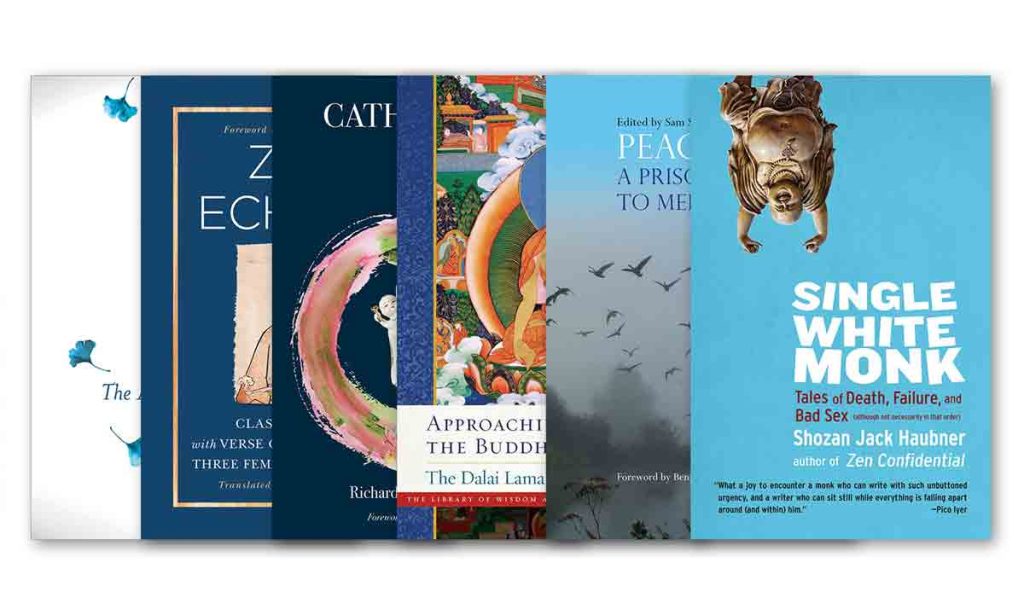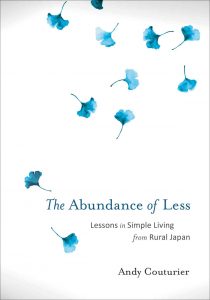 If you’re a city dweller, chances are you’ve indulged in fantasies of abandoning your hectic technology– and consumption- centric days to cultivate a life of the land. I’ll grow my own food! Keep goats! Knit socks! This remains fantasy for most. But not for the ten men and women profiled in Andy Couturier’s The Abundance of Less: Lessons in Simple Living from Rural Japan (North Atlantic Books, August 2017; $19.95, 336 pp., paper), who have actually cast aside the urban morass of materialism for lives that allow time for the things that matter.
If you’re a city dweller, chances are you’ve indulged in fantasies of abandoning your hectic technology– and consumption- centric days to cultivate a life of the land. I’ll grow my own food! Keep goats! Knit socks! This remains fantasy for most. But not for the ten men and women profiled in Andy Couturier’s The Abundance of Less: Lessons in Simple Living from Rural Japan (North Atlantic Books, August 2017; $19.95, 336 pp., paper), who have actually cast aside the urban morass of materialism for lives that allow time for the things that matter.
Couturier’s subjects, living in rural Japan, make miso by hand, homeschool their children, harvest their own rice, and practice a wide array of arts, including flute playing, batik, painting, and dance. In their spare time they are often active in their communities, like Atsuko Watanabe, one of those profiled, who spends her time away from tilling the soil engaging in antinuclear power protests and writing letters on behalf of Amnesty International. Their lives and voices exhibit a rare ethical clarity.
Couturier, who spent four years in Japan studying sustainable living, approaches these individuals with such respect and admiration that each relationship seems not so much that of a writer and an interviewee as that of a student and teacher. The profiles will compel readers to consider how they might live more simply and increase their civic engagement.
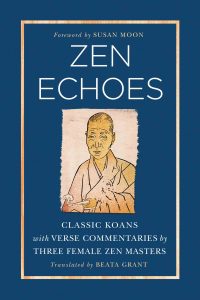 Belonging to a lineage is powerful: among other things, it provides a succession of role models past for practitioners of the present. The only catch—for women, anyway—is that all of the prominent lineage holders are male. Fortunately, some modern-day masters have recognized female leaders among their students, and scholarship is gradually identifying and publishing the stories of women in history who were major teachers.
Belonging to a lineage is powerful: among other things, it provides a succession of role models past for practitioners of the present. The only catch—for women, anyway—is that all of the prominent lineage holders are male. Fortunately, some modern-day masters have recognized female leaders among their students, and scholarship is gradually identifying and publishing the stories of women in history who were major teachers.
Now Beata Grant, Professor of Chinese and Religious Studies at Washington University, has made an important contribution to this field by translating the writings of three female Zen Buddhist masters into English for the first time, making them and their work known to contemporary students. Zen Echoes: Classic Koans with Verse Commentaries by Three Female Zen Masters (Wisdom Publications, May 2017; $16.95, 176 pp., paper) is a collection of key Chan koans paired with commentaries by the 12th-century Buddhist nun Miaozong. A brilliant practitioner and dharma heir to the eminent Chan master Dahui, Miaozong was known for her literary works as well as her verse commentaries, or songgu, such as those in the present collection, which managed to survive to the 17th century. Two later female masters and dharma friends, Baochi and Zukui, were so inspired by Miaozong’s work that they wrote their own verse commentaries in response.
These writings speak across centuries, bearing witness to an actual plurality of voices in the historical record of the dharma, and giving evidence of the strength of a female role model for later generations. As Grant reminds us in the book’s introduction: “in composing these verses, Miaozong, Baochi, and Zukui were claiming for themselves the same religious and spiritual authority as their male counterparts, no more and no less.”
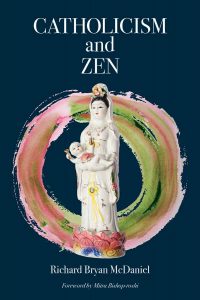 The relationship between Catholicism and Zen Buddhism began as most missionary undertakings do: with a big misunderstanding. In the mid-16th century, Jesuit priest Francis Xavier traveled to Japan to convert its “heathens” and met a hospitable local lord, Shimazu Takahisa, whose coat of arms happened to bear the image of a cross within a circle. This discovery, and the fact that Buddhist clergy “prayed” with folded hands and with a bastardized “rosary,” led Francis to speculate that the apostle Thomas had already brought Christianity to Japan centuries earlier, and that the religion had become distorted over time due to its geographic and cultural remove.
The relationship between Catholicism and Zen Buddhism began as most missionary undertakings do: with a big misunderstanding. In the mid-16th century, Jesuit priest Francis Xavier traveled to Japan to convert its “heathens” and met a hospitable local lord, Shimazu Takahisa, whose coat of arms happened to bear the image of a cross within a circle. This discovery, and the fact that Buddhist clergy “prayed” with folded hands and with a bastardized “rosary,” led Francis to speculate that the apostle Thomas had already brought Christianity to Japan centuries earlier, and that the religion had become distorted over time due to its geographic and cultural remove.
Richard Bryan McDaniel’s book Catholicism and Zen (The Sumeru Press, January 2017; $26.95, 210 pp., paper) recounts this historical encounter and others in the record of Buddhist-Catholic relations, traveling through time to chronicle the Jesuits’ befuddlement over Buddhist concepts such as emptiness and anatta, or no-self, and exploring the contributions that Jesuit scholar William Johnston, Trappist monk Thomas Merton, and others made to a Western understanding of Zen.
The bulk of the volume, however, comprises conversations between the author, fellow Zen practitioners, and Catholic clergymen and-women who offer their take on how the traditions complement, rather than conflict with, each other. Merton himself cited a quote from the apostle Paul that expresses a kind of harmony between the faiths: “I live, now not I, but Christ lives within me.”
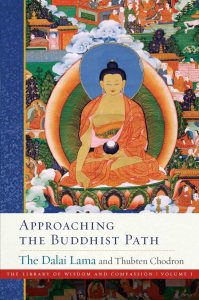 “Examine these teachings and use reasoning. Practice them and see through your own experience if they work. Then decide if you want to adopt them.” This was the advice that Tibetan lamas gave to Thubten Chodron back when she was 24-year-old Cheryl Green, a young woman interested in the dharma. Their “come and see” attitude was part of what drew her to the Buddhist teachings, and it stoked a passion that eventually led her to ordination and her role today as the celebrated author and abbess of Sravasti Abbey, the only Tibetan Buddhist monastery for Western nuns and monks in the United States.
“Examine these teachings and use reasoning. Practice them and see through your own experience if they work. Then decide if you want to adopt them.” This was the advice that Tibetan lamas gave to Thubten Chodron back when she was 24-year-old Cheryl Green, a young woman interested in the dharma. Their “come and see” attitude was part of what drew her to the Buddhist teachings, and it stoked a passion that eventually led her to ordination and her role today as the celebrated author and abbess of Sravasti Abbey, the only Tibetan Buddhist monastery for Western nuns and monks in the United States.
Approaching the Buddhist Path (Wisdom Publications, August 2017; $29.95, 360 pp., cloth) is written in the same “come and see” spirit. It is the product of the collaboration between Thubten Chodron and the current Dalai Lama and the first in a projected series of eight titles of His Holiness’s teachings describing the path to buddhahood in the Nalanda tradition. In clear language, it provides the reader with the foundational knowledge necessary to study Tibetan Buddhist philosophical texts that have been translated into English, and it links the teachings to formal meditation practice and daily life. Students of Tibetan Buddhism who have moved beyond a general interest and are looking for a thorough and organized overview of the path need look no further.
You’ll find some unexpected topics in Shozan Jack Haubner’s latest book, Single White Monk (Shambhala Publications, October  2017; $14.95, 208 pp., paper): a 300-page sheaf of emails to an ex-girlfriend, the Bible, a MacBook theft, pancreatitis-induced projectile vomiting, Mr. Olympia bodybuilder Lee Haney . . . and that’s just the beginning.
2017; $14.95, 208 pp., paper): a 300-page sheaf of emails to an ex-girlfriend, the Bible, a MacBook theft, pancreatitis-induced projectile vomiting, Mr. Olympia bodybuilder Lee Haney . . . and that’s just the beginning.
In the nine essays that make up the first half of the book, Haubner examines the mess of life, both in and out of the zendo, from the perspective of a monk who describes himself as “forty, single, and still not totally sure what I want to do with my life.” Throughout, he softens the blow of his signature self-honesty with humor, another hallmark quality of his writing. (In one story, he describes his scrawny pubescent self as a “bug-eyed seventh grader in a spaghetti-string tank top, curling buckets of rocks in the basement and squeaking self-encouragements like an amped-up field mouse.”) The second half, a novella, recounts his experiences as the head monk of Joshu Sasaki Roshi’s temple in the aftermath of the many sexual assault allegations against the teacher.
As is perhaps fitting for a Zen monk, Haubner describes his writing not as nonfiction but rather as “personal mythology” based on journal entries, faulty memory, fiction, and reportage. In the book’s introduction, he takes another decidedly Zen take on things: “events described are not a record of objective reality. They are the fever dream of a man wrestling with his memory, his teacher, his lovers, his peers, and himself. Let’s just say it was inspired by a true story—as if there were such a thing.”
Haubner’s humor, irreverence, and willingness to expose the hairy truth is never used to cheap effect. His writing reflects life back to you: love, self-doubt, lust, disgust, and devotion all have their place here. His stories speak to the core.
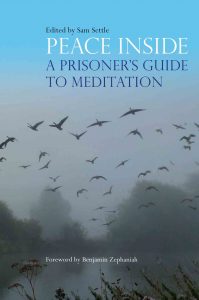 Peace Inside: A Prisoner’s Guide to Meditation (Jessica Kingsley Publishers, April 2017; $18.95, 272 pp., paper) begins this way: “There’s a good chance you’re reading this in a prison cell.” And if you’re a reader in the United States, there certainly is. Today more than two million Americans are in jail, which is roughly a quarter of the world’s prison population—an outrageous number when we consider that the United States is home to around 5 percent of the globe’s people.
Peace Inside: A Prisoner’s Guide to Meditation (Jessica Kingsley Publishers, April 2017; $18.95, 272 pp., paper) begins this way: “There’s a good chance you’re reading this in a prison cell.” And if you’re a reader in the United States, there certainly is. Today more than two million Americans are in jail, which is roughly a quarter of the world’s prison population—an outrageous number when we consider that the United States is home to around 5 percent of the globe’s people.
Although the prison industrial complex can’t be dismantled through meditation, a number of organizations are working today to bring sitting and awareness practices to prisoners with the hope that these will provide them some measure of mental, emotional, and spiritual freedom. One such organization is the Prison Phoenix Trust (PPT), a UK- based charity directed by the book’s editor, Sam Settle, a former Buddhist monk.
Peace Inside—the book is available free to any prisoner in the UK or Ireland who requests it—presents clear, simple instructions and illustrative diagrams that will aid any novice sitter. In its “how to meditate” chapters, Settle addresses needs specific to prisoners, like how to make a cell more meditation-friendly (empty your ashtray, make your bed). The second half of the book is a series of letters ex- changed between PPT’s multifaith volunteers and inmate practitioners, who write back and forth about anger and violence, hope and regret, and depression, boredom, and doubt.
Though in some ways the prisoners’ lives are vastly different from those on the outside, these keyhole glimpses into their internal worlds show that in other ways they are exactly the same—a point that will not be lost on readers.
Thank you for subscribing to Tricycle! As a nonprofit, we depend on readers like you to keep Buddhist teachings and practices widely available.
